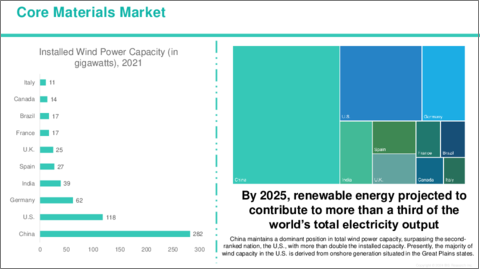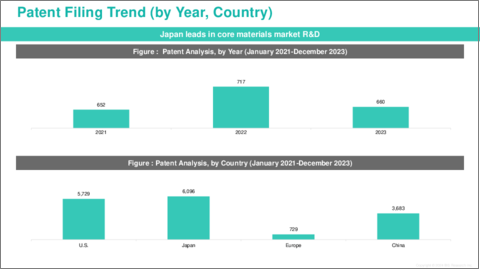|
|
市場調査レポート
商品コード
1489279
コア材料市場- 世界および地域別分析:最終用途産業別、タイプ別、地域別 - 分析と予測(2024年~2034年)Core Materials Market - A Global and Regional Analysis: Focus on End-use Industry, Type, and Region - Analysis and Forecast, 2024-2034 |
||||||
カスタマイズ可能
|
|||||||
| コア材料市場- 世界および地域別分析:最終用途産業別、タイプ別、地域別 - 分析と予測(2024年~2034年) |
|
出版日: 2024年06月06日
発行: BIS Research
ページ情報: 英文 100 Pages
納期: 1~5営業日
|
全表示
- 概要
- 目次
コア材料の市場規模は、様々な主な要因や市場促進要因によって大きな成長を遂げています。
楽観的シナリオでは、2024年の市場規模は19億2,000万米ドルで、12.09%のCAGRで拡大し、2034年には60億3,000万米ドルに達すると予測されています。
| 主要市場統計 | |
|---|---|
| 予測期間 | 2024年~2034年 |
| 2024年評価 | 19億2,000万米ドル |
| 2034年予測 | 60億3,000万米ドル |
| CAGR | 12.09% |
この成長の主な原動力は、様々な産業において、製品性能の向上と製造コストの削減における先端コア材料の利点が認識されつつあることです。先端コア材料は、最終製品の構造的完全性、軽量化、耐久性の向上において重要な役割を果たし、業務効率と費用対効果の向上につながります。この需要は、製品競争力と市場差別化を確保する上で先端材料が重要であるという産業界の理解が高まっていることから生じています。
さらに、持続可能性と環境規制の重視が高まっていることも、先端コア材料の採用を後押ししています。カーボンフットプリントの削減と環境に優しい製造方法の推進に焦点が当てられる中、再生可能な資源やリサイクル材料から派生した先端コア材料に注目する企業が増えています。この動向は、製造工程における持続可能な材料の使用を促進する政府の取り組みやインセンティブによってさらに加速しています。
当レポートでは、世界のコア材料市場について調査し、市場の概要とともに、最終用途産業別、タイプ別、地域別の動向、および市場に参入する企業のプロファイルなどを提供しています。
目次
エグゼクティブサマリー
第1章 市場:業界の展望
- 動向:現在および将来の影響評価
- サプライチェーンの概要
- R&Dレビュー
- 規制状況
- ステークホルダー分析
- 主要な世界的イベントの影響分析
- 市場力学の概要
第2章 コア材料市場(用途別)
- 用途のセグメンテーション
- 用途の概要
- コア材料市場(最終用途産業別)
第3章 コア材料市場(製品別)
- 製品セグメンテーション
- 製品概要
- コア材料市場(タイプ別)
第4章 コア材料市場(地域別)
- コア材料市場(地域別)
- 北米
- 欧州
- アジア太平洋
- その他の地域
第5章 企業プロファイル
- 今後の見通し
- 地理的評価
- Hexcel Corporation
- Gurit Holdings AG
- Evonik Industries AG
- 3A Composites
- Armacell
- Diab Group
- The Gill Corporation
- Plascore Inc.
- EURO-COMPOSITES
- Toray Industries, Inc.
- Corelite
- I-Core Composites
- Sicomin
- Maricell Core Composites
- RelCore Composites Inc.
- その他の主要企業
第6章 調査手法
Introduction to Core Materials Market
The core materials market is experiencing significant growth, driven by various key factors and market drivers. In an optimistic scenario, the market is valued at $1.92 billion in 2024 and is anticipated to expand at a CAGR of 12.09% to reach $6.03 billion by 2034.
| KEY MARKET STATISTICS | |
|---|---|
| Forecast Period | 2024 - 2034 |
| 2024 Evaluation | $1.92 Billion |
| 2034 Forecast | $6.03 Billion |
| CAGR | 12.09% |
A primary driver for this growth is the increasing recognition of the benefits of advanced core materials in enhancing product performance and reducing manufacturing costs across various industries. Advanced core materials play a crucial role in improving structural integrity, lightweighting, and durability of end products, leading to enhanced operational efficiency and cost-effectiveness. This demand arises from industries' growing understanding of the importance of advanced materials in ensuring product competitiveness and market differentiation.
Additionally, the rising emphasis on sustainability and environmental regulations is driving the adoption of advanced core materials. With the focus on reducing carbon footprint and promoting eco-friendly manufacturing practices, organizations are increasingly turning to advanced core materials derived from renewable sources or recycled materials. This trend is further accelerated by government initiatives and incentives promoting the use of sustainable materials in manufacturing processes.
Furthermore, technological advancements and innovations in core material manufacturing processes are creating opportunities for market expansion. Companies specializing in core materials, such as 3A Composites, Hexcel Corporation, and Gurit Holdings AG, are at the forefront of developing innovative solutions tailored to the specific needs of different industries. Their expertise in materials science, engineering capabilities, and customer-centric approach are instrumental in shaping the global core materials market landscape.
Overall, the core materials market is witnessing robust growth, driven by the increasing recognition of its benefits, sustainability trends, and technological advancements, coupled with the development of innovative solutions by key market players.
Market Segmentation:
Segmentation 1: by End-use Industry
- Wind Energy
- Aerospace and Defence
- Marine
- Automation and Transportation
- Construction
- Industrial
- Others
Segmentation 2: by Type
- Foam
- Honeycomb
- Balsa
Segmentation 3: by Region
- North America
- Europe
- Asia-Pacific
- Rest-of-the-World
How can this report add value to an organization?
Product/Innovation Strategy: The global core materials market has been extensively segmented based on various categories, such as end-use industry, type, and region. This can help readers get a clear overview of which segments account for the largest share and which ones are well-positioned to grow in the coming years.
Competitive Strategy: A detailed competitive benchmarking of the players operating in the global core materials market has been done to help the reader understand how players stack against each other, presenting a clear market landscape. Additionally, comprehensive competitive strategies such as partnerships, agreements, and collaborations will aid the reader in understanding the untapped revenue pockets in the market.
Key Market Players and Competition Synopsis
The companies that are profiled have been selected based on thorough secondary research, which includes analyzing company coverage, product portfolio, market penetration, and insights gathered from primary experts.
Some prominent names established in this market are:
- Hexcel Corporation
- Evonik Industries AG
- Diab Group
- Armacell
- 3A Composites
- The Gill Corporation
Key Questions Answered in this Report:
- What are the main factors driving the demand for core materials market?
- What are the major patents filed by the companies active in the core materials market?
- Who are the key players in the core materials market, and what are their respective market shares?
- What partnerships or collaborations are prominent among stakeholders in the core materials market?
- What are the strategies adopted by the key companies to gain a competitive edge in core materials market?
- What is the futuristic outlook for the core materials market in terms of growth potential?
- What is the current estimation of the core materials market, and what growth trajectory is projected from 2024 to 2034?
- Which application, and product segment is expected to lead the market over the forecast period (2024-2034)?
- Which regions demonstrate the highest adoption rates for core materials market, and what factors contribute to their leadership?
Table of Contents
Executive Summary
Scope and Definition
Market/Product Definition
Key Questions Answered
Analysis and Forecast Note
1 Markets: Industry Outlook
- 1.1 Trends: Current and Future Impact Assessment
- 1.2 Supply Chain Overview
- 1.2.1 Value Chain Analysis
- 1.2.2 Pricing Forecast
- 1.3 R&D Review
- 1.3.1 Patent Filing Trend by Country, by Company
- 1.4 Regulatory Landscape
- 1.5 Stakeholder Analysis
- 1.5.1 Use Case
- 1.5.2 End User and Buying Criteria
- 1.6 Impact Analysis for Key Global Events
- 1.7 Market Dynamics Overview
- 1.7.1 Market Drivers
- 1.7.2 Market Restraints
- 1.7.3 Market Opportunities
2 Core Materials Market (by Application)
- 2.1 Application Segmentation
- 2.2 Application Summary
- 2.3 Core Materials Market (by End-use Industry)
- 2.3.1 Wind Energy
- 2.3.2 Aerospace and Defence
- 2.3.3 Marine
- 2.3.4 Automation and Transportation
- 2.3.5 Construction
- 2.3.6 Industrial
- 2.3.7 Others
3 Core Materials Market (by Products)
- 3.1 Product Segmentation
- 3.2 Product Summary
- 3.3 Core Materials Market (by Type)
- 3.3.1 Foam
- 3.3.2 Honeycomb
- 3.3.3 Balsa
4 Core Materials Market (by Region)
- 4.1 Core Materials Market (by Region)
- 4.2 North America
- 4.2.1 Regional Overview
- 4.2.2 Driving Factors for Market Growth
- 4.2.3 Factors Challenging the Market
- 4.2.4 Application
- 4.2.5 Product
- 4.2.6 U.S.
- 4.2.6.1 Market by Application
- 4.2.6.2 Market by Product
- 4.2.7 Canada
- 4.2.7.1 Market by Application
- 4.2.7.2 Market by Product
- 4.2.8 Mexico
- 4.2.8.1 Market by Application
- 4.2.8.2 Market by Product
- 4.3 Europe
- 4.3.1 Regional Overview
- 4.3.2 Driving Factors for Market Growth
- 4.3.3 Factors Challenging the Market
- 4.3.4 Application
- 4.3.5 Product
- 4.3.6 Germany
- 4.3.6.1 Market by Application
- 4.3.6.2 Market by Product
- 4.3.7 France
- 4.3.7.1 Market by Application
- 4.3.7.2 Market by Product
- 4.3.8 U.K.
- 4.3.8.1 Market by Application
- 4.3.8.2 Market by Product
- 4.3.9 Italy
- 4.3.9.1 Market by Application
- 4.3.9.2 Market by Product
- 4.3.10 Rest-of-Europe
- 4.3.10.1 Market by Application
- 4.3.10.2 Market by Product
- 4.4 Asia-Pacific
- 4.4.1 Regional Overview
- 4.4.2 Driving Factors for Market Growth
- 4.4.3 Factors Challenging the Market
- 4.4.4 Application
- 4.4.5 Product
- 4.4.6 China
- 4.4.6.1 Market by Application
- 4.4.6.2 Market by Product
- 4.4.7 Japan
- 4.4.7.1 Market by Application
- 4.4.7.2 Market by Product
- 4.4.8 India
- 4.4.8.1 Market by Application
- 4.4.8.2 Market by Product
- 4.4.9 South Korea
- 4.4.9.1 Market by Application
- 4.4.9.2 Market by Product
- 4.4.10 Rest-of-Asia-Pacific
- 4.4.10.1 Market by Application
- 4.4.10.2 Market by Product
- 4.5 Rest-of-the-World
- 4.5.1 Regional Overview
- 4.5.2 Driving Factors for Market Growth
- 4.5.3 Factors Challenging the Market
- 4.5.4 Application
- 4.5.5 Product
- 4.5.6 South America
- 4.5.6.1 Market by Application
- 4.5.6.2 Market by Product
- 4.5.7 Middle East and Africa
- 4.5.7.1 Market by Application
- 4.5.7.2 Market by Product
5 Companies Profiled
- 5.1 Next Frontiers
- 5.2 Geographic Assessment
- 5.2.1 Hexcel Corporation
- 5.2.1.1 Overview
- 5.2.1.2 Top Products/Product Portfolio
- 5.2.1.3 Top Competitors
- 5.2.1.4 Target Customers
- 5.2.1.5 Key Personnel
- 5.2.1.6 Analyst View
- 5.2.1.7 Market Share
- 5.2.2 Gurit Holdings AG
- 5.2.2.1 Overview
- 5.2.2.2 Top Products/Product Portfolio
- 5.2.2.3 Top Competitors
- 5.2.2.4 Target Customers
- 5.2.2.5 Key Personnel
- 5.2.2.6 Analyst View
- 5.2.2.7 Market Share
- 5.2.3 Evonik Industries AG
- 5.2.3.1 Overview
- 5.2.3.2 Top Products/Product Portfolio
- 5.2.3.3 Top Competitors
- 5.2.3.4 Target Customers
- 5.2.3.5 Key Personnel
- 5.2.3.6 Analyst View
- 5.2.3.7 Market Share
- 5.2.4 3A Composites
- 5.2.4.1 Overview
- 5.2.4.2 Top Products/Product Portfolio
- 5.2.4.3 Top Competitors
- 5.2.4.4 Target Customers
- 5.2.4.5 Key Personnel
- 5.2.4.6 Analyst View
- 5.2.4.7 Market Share
- 5.2.5 Armacell
- 5.2.5.1 Overview
- 5.2.5.2 Top Products/Product Portfolio
- 5.2.5.3 Top Competitors
- 5.2.5.4 Target Customers
- 5.2.5.5 Key Personnel
- 5.2.5.6 Analyst View
- 5.2.5.7 Market Share
- 5.2.6 Diab Group
- 5.2.6.1 Overview
- 5.2.6.2 Top Products/Product Portfolio
- 5.2.6.3 Top Competitors
- 5.2.6.4 Target Customers
- 5.2.6.5 Key Personnel
- 5.2.6.6 Analyst View
- 5.2.6.7 Market Share
- 5.2.7 The Gill Corporation
- 5.2.7.1 Overview
- 5.2.7.2 Top Products/Product Portfolio
- 5.2.7.3 Top Competitors
- 5.2.7.4 Target Customers
- 5.2.7.5 Key Personnel
- 5.2.7.6 Analyst View
- 5.2.7.7 Market Share
- 5.2.8 Plascore Inc.
- 5.2.8.1 Overview
- 5.2.8.2 Top Products/Product Portfolio
- 5.2.8.3 Top Competitors
- 5.2.8.4 Target Customers
- 5.2.8.5 Key Personnel
- 5.2.8.6 Analyst View
- 5.2.8.7 Market Share
- 5.2.9 EURO-COMPOSITES
- 5.2.9.1 Overview
- 5.2.9.2 Top Products/Product Portfolio
- 5.2.9.3 Top Competitors
- 5.2.9.4 Target Customers
- 5.2.9.5 Key Personnel
- 5.2.9.6 Analyst View
- 5.2.9.7 Market Share
- 5.2.10 Toray Industries, Inc.
- 5.2.10.1 Overview
- 5.2.10.2 Top Products/Product Portfolio
- 5.2.10.3 Top Competitors
- 5.2.10.4 Target Customers
- 5.2.10.5 Key Personnel
- 5.2.10.6 Analyst View
- 5.2.10.7 Market Share
- 5.2.11 Corelite
- 5.2.11.1 Overview
- 5.2.11.2 Top Products/Product Portfolio
- 5.2.11.3 Top Competitors
- 5.2.11.4 Target Customers
- 5.2.11.5 Key Personnel
- 5.2.11.6 Analyst View
- 5.2.11.7 Market Share
- 5.2.12 I-Core Composites
- 5.2.12.1 Overview
- 5.2.12.2 Top Products/Product Portfolio
- 5.2.12.3 Top Competitors
- 5.2.12.4 Target Customers
- 5.2.12.5 Key Personnel
- 5.2.12.6 Analyst View
- 5.2.12.7 Market Share
- 5.2.13 Sicomin
- 5.2.13.1 Overview
- 5.2.13.2 Top Products/Product Portfolio
- 5.2.13.3 Top Competitors
- 5.2.13.4 Target Customers
- 5.2.13.5 Key Personnel
- 5.2.13.6 Analyst View
- 5.2.13.7 Market Share
- 5.2.14 Maricell Core Composites
- 5.2.14.1 Overview
- 5.2.14.2 Top Products/Product Portfolio
- 5.2.14.3 Top Competitors
- 5.2.14.4 Target Customers
- 5.2.14.5 Key Personnel
- 5.2.14.6 Analyst View
- 5.2.14.7 Market Share
- 5.2.15 RelCore Composites Inc.
- 5.2.15.1 Overview
- 5.2.15.2 Top Products/Product Portfolio
- 5.2.15.3 Top Competitors
- 5.2.15.4 Target Customers
- 5.2.15.5 Key Personnel
- 5.2.15.6 Analyst View
- 5.2.15.7 Market Share
- 5.2.16 Other Key Companies
- 5.2.1 Hexcel Corporation





